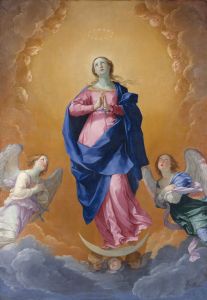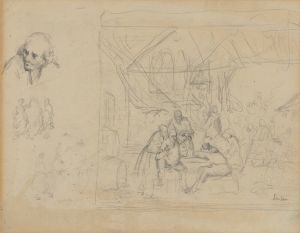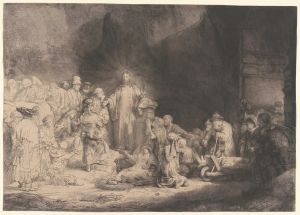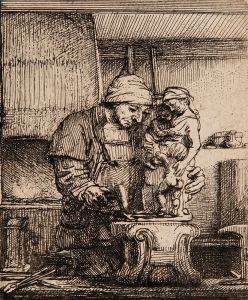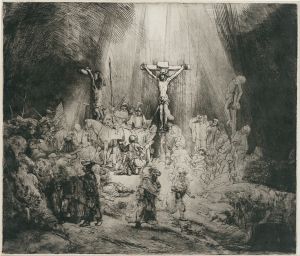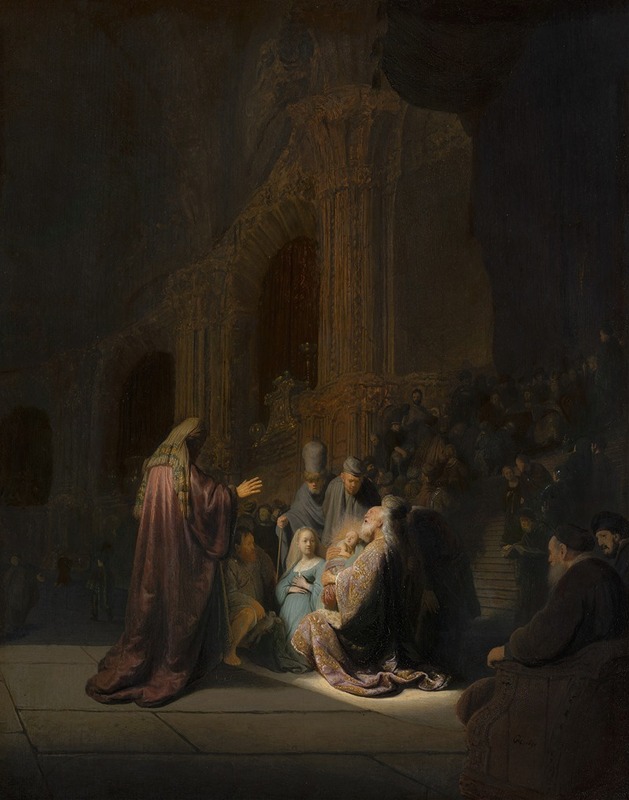
Simeon’s Song of Praise
A hand-painted replica of Rembrandt van Rijn’s masterpiece Simeon’s Song of Praise, meticulously crafted by professional artists to capture the true essence of the original. Each piece is created with museum-quality canvas and rare mineral pigments, carefully painted by experienced artists with delicate brushstrokes and rich, layered colors to perfectly recreate the texture of the original artwork. Unlike machine-printed reproductions, this hand-painted version brings the painting to life, infused with the artist’s emotions and skill in every stroke. Whether for personal collection or home decoration, it instantly elevates the artistic atmosphere of any space.
Simeon’s Song of Praise is a painting by the renowned Dutch artist Rembrandt van Rijn, completed in 1631. This work is an early example of Rembrandt's mastery in the use of light and shadow, a technique known as chiaroscuro, which he employed to bring dramatic intensity and emotional depth to his subjects. The painting is housed in the Mauritshuis museum in The Hague, Netherlands.
The painting depicts a biblical scene from the Gospel of Luke, where Simeon, a devout and righteous man, holds the infant Jesus in his arms. According to the biblical narrative, Simeon had been promised by the Holy Spirit that he would not die before he had seen the Messiah. Upon seeing Jesus at the temple, Simeon recognizes him as the Savior and utters a hymn of praise, known as the Nunc Dimittis or Simeon’s Song of Praise. This moment of revelation and fulfillment is captured by Rembrandt with profound sensitivity.
In the composition, Simeon is portrayed as an elderly man with a serene and contemplative expression, emphasizing his spiritual enlightenment and inner peace. The infant Jesus is depicted with a gentle, divine presence, reinforcing the theme of salvation and hope. The use of light in the painting is particularly striking; Rembrandt illuminates the figures of Simeon and Jesus, drawing the viewer's attention to their interaction and highlighting the significance of the moment. The background is kept in shadow, creating a sense of intimacy and focus on the central figures.
Rembrandt's ability to convey emotion and narrative through his portraits is evident in this work. The textures of the clothing and the delicate rendering of Simeon's aged features demonstrate Rembrandt's skill in capturing human character and emotion. The painting reflects Rembrandt's interest in religious themes and his ability to interpret them in a way that resonates with viewers on a personal and spiritual level.
Simeon’s Song of Praise is a testament to Rembrandt's early talent and his evolving style. During this period, Rembrandt was establishing himself as a leading artist in Amsterdam, and his work was beginning to attract significant attention. This painting, along with others from the same period, showcases his growing expertise in portraiture and his innovative approach to biblical subjects.
The painting's historical significance lies not only in its artistic merit but also in its reflection of the cultural and religious context of the Dutch Golden Age. During this time, there was a strong interest in biblical stories and their moral and spiritual implications, which were often explored through art. Rembrandt's interpretation of these themes contributed to his reputation as one of the greatest painters of his time.
Overall, Simeon’s Song of Praise is a remarkable example of Rembrandt's early work, illustrating his ability to combine technical skill with deep emotional and spiritual insight. The painting continues to be admired for its beauty and its powerful depiction of a moment of divine revelation.







